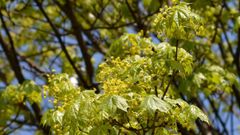









The Common maple(Acer platanoides) is a deciduous tree native to Europe and Asia that has been introduced to North America where it tends to become invasive. It is sometimes confused with the sugar maple whose leaf adorns the Canadian flag, but they are not the same species.
Planting maple trees in our forests can be beneficial for various reasons. Diversity of species in a forest is always an asset, provided that the soils, the requirements of the forest site and the native species are respected. We know that trees absorb carbon dioxide (CO2 ) and produce oxygen (O2), which is good for air quality and helps us to slow down global warming. Flat maples with very large leaves can absorb more carbon dioxide than other tree species. In addition, these maples are fast growing and provide a habitat for wildlife such as birds, squirrels and bats. Planting flat maples can therefore help to support local biodiversity.
Theflat maple is also an ornamental tree that provides beauty in all seasons: in summer with its large green leaves, in autumn with its magnificent red and orange colours and in winter with its majestic habit.
Its wood is also used as lumber or industrial wood, particularly for making furniture and paper pulp.
Theflat maple is a relatively hardy tree species, a light species that tolerates some shade when young. It is adapted to a temperate climate with warm summers and cold winters. It appreciates base and nitrogen rich, cool and well aerated soils. When young, it needs regular watering but can tolerate dry periods as an adult.
Flat maple wood is a valuable and versatile material, known for its hardness and strength, which makes it suitable for a wide variety of uses. It is used for flooring, furniture, musical instruments (guitars, pianos, drums, etc.), kitchen utensils and paper pulp. Its light yellow wood is highly sought after when flamed. It is therefore often used for high-end furniture, veneers, flooring and mouldings. Its wood is also durable and impact resistant, making it a material of choice for items that are used daily, such as kitchen utensils and tools.
Theflat maple is a tree with rich symbolism across the cultures of the world. It is considered a symbol of strength and resilience because of its ability to survive in harsh conditions and to regenerate after events such as forest fires. In Asian culture, theflat maple is often considered a symbol of prosperity and good luck because of its auspicious hand-like leaf shape. TheFlat Maple is also considered a symbol of beauty because of the unique colour and texture of its wood, as well as the beautiful hues of its leaves in the fall. The Celts considered it a tree with magical powers and it was often linked to the Druids.